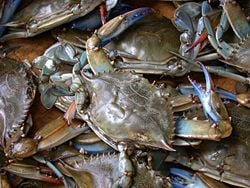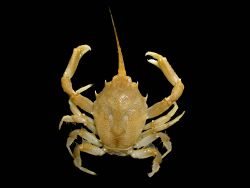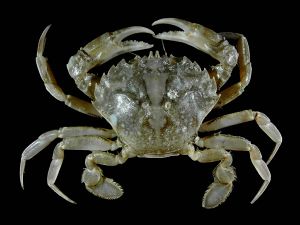Difference between revisions of "Crab" - New World Encyclopedia
Rick Swarts (talk | contribs) |
m ({{Contracted}}) |
||
| Line 1: | Line 1: | ||
| + | {{Contracted}} | ||
— need to add most recent version — | — need to add most recent version — | ||
Revision as of 15:53, 24 November 2006
— need to add most recent version —
| Crabs | ||||||||||||||
|---|---|---|---|---|---|---|---|---|---|---|---|---|---|---|
 Callinectes sapidus | ||||||||||||||
| Scientific classification | ||||||||||||||
| ||||||||||||||
| Sections | ||||||||||||||
|
The term crab is often applied to several different groups of short (nose to tail) decapod crustaceans with thick exoskeletons, but only members of the Brachyura are true crabs. Other taxa, such as hermit crabs, porcelain crabs and king crabs are, despite superficial similarities, not crabs at all; rather, they belong to the Anomura and can be distinguished from true crabs by counting the legs. In Anomura, the last pair of pereiopods (walking legs) is hidden inside the carapace, so only four pairs are visible (counting the claws), whereas uninjured true crabs always have five visible pairs.
True crabs
True crabs are crustaceans in the infraorder Brachyura, in the order Decapoda. They have five pairs of walking legs (the first of which is modified into a pair of claws or chelae) and typically a flattened shell. In all but a few crabs (for example, Raninoida), the abdomen is folded under the cephalothorax. The form of the abdomen usually reveals the sex of the crab; males have a narrow abdomen, while females have a much wider abdomen, under which they carry their eggs. Crabs are a very diverse group, mostly found in saltwater, but with some groups living in freshwater or on land. Although famed for their tendency to walk sideways, crabs are in fact able to walk in any direction. Classification within the crabs is traditionally based on the position of the gonopores: whether they are found on the legs or on the thorax. In the two "primitive" sections (sometimes called collectively the "Podotremata"), the gonopores are found on the legs (as in all other decapods); in the Heterotremata, the male gonopores are on the legs, and the female gonopores are on the sternum; in the Thoracotremata, the gonopores are on the sternum in both males and females.
Sexual dimorphism
Most crabs show clear sexual dimorphism and so can be easily sexed. The abdomen, which is held recurved under the thorax, is narrow in males. In females, however, the abdomen is considerably wider, and retains a greater number of pleopods. This relates to the carrying of the fertilised eggs by the female crabs (as seen in all pleocyemates). In those species in which no such dimorphism is found, the position of the gonopores must be used instead. In females, these are on the third pereiopod, or nearby on the sternum in higher crabs; in males, the gonopores are at the base of the fifth pereiopods or, in higher crabs, on the sternum nearby.
Crab fishery
Crabs make up 20% of all marine crustaceans caught and farmed worldwide, with over 1½ million tonnes being consumed annually. Of that total, one species accounts for one fifth: Portunus trituberculatus. Other important taxa include Portunus pelagicus, several species in the genus Chionoecetes, the blue crab (Callinectes sapidus), the blue land crab (Discoplax hirtipes), the genus Charybdis, the edible crab (Cancer pagurus), the Dungeness crab (Cancer magister) and Scylla serrata, each of which provides more than 20,000 tonnes annually.
Other animals
A number of animals with a similar shape are commonly called crabs, including the crab louse (an insect) and the horseshoe crab (in the class Merostomata). The crab louse is the origin of the slang term "crabs" for an infestation of pubic lice.
Superfamilies
- Bellioidea
- Bythograeoidea
- Calappoidea
- Cancroidea
- Cryptochiroidea
- Cyclodorippoidea
- Dorippoidea
- Dromioidea
- Gecarcinucoidea
- Grapsoidea
- Homolodromioidea
- Homoloidea
- Hymenosomatoidea
- Leucosioidea
- Majoidea
- Ocypodoidea
- Parthenopoidea
- Pinnotheroidea
- Portunoidea
- Potamoidea
- Pseudothelphuspoidea
- Raninoidea
- Retroplumoidea
- Xanthoidea
External links
- Brachyura entry at ITIS Report
- Brachyura entry at Animal diversity web
- Crab Hunt in Kudat, Sabah, East Malaysia
- Spotlight on: Osmoregulation and ion transport in crab gills
Credits
New World Encyclopedia writers and editors rewrote and completed the Wikipedia article in accordance with New World Encyclopedia standards. This article abides by terms of the Creative Commons CC-by-sa 3.0 License (CC-by-sa), which may be used and disseminated with proper attribution. Credit is due under the terms of this license that can reference both the New World Encyclopedia contributors and the selfless volunteer contributors of the Wikimedia Foundation. To cite this article click here for a list of acceptable citing formats.The history of earlier contributions by wikipedians is accessible to researchers here:
The history of this article since it was imported to New World Encyclopedia:
Note: Some restrictions may apply to use of individual images which are separately licensed.

